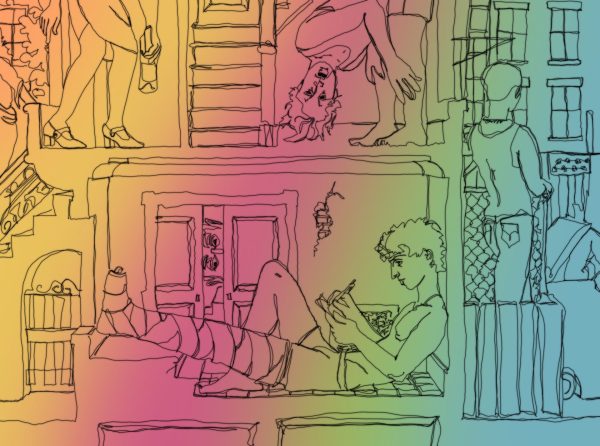‘Euphoria’ creates another suspenseful season through destigmatization
Zendaya plays Rue Bennett, the main character in the TV show Euphoria as a teenager addicted to drugs.
After a season full of drug withdrawal, gaslighting and a theatrical exposé, “Euphoria” continues to go beyond being just another drama by destigmatizing drug use, sex work and sexuality.
“I think that ‘Euphoria’ as a show walks the fine line of humanizing versus glamorizing the situations and lives all the characters lead,” Loyola Chicago student and “Euphoria” fan Meghan Pfeiffer said. “I also think that the fantasy, dream-like sequences intertwined with [these acts] contribute to this.”
There are plenty of examples of destigmatization in this season, but most prevalent was Fez, the local drug dealer. According to a report by the U.S. Department of Justice, 46 percent of federal prisoners in 2019 were serving a drug-related sentence, showing how society has historically criminalized and looked down on drug use. Despite this, “Euphoria” gave Fez the spotlight in several instances, showing the humanity behind the character.
One example of this was through his relationship with Lexi, the rather quiet girl who did not partake in the drug culture her friends surrounded themselves with. As the two got more involved, TikTok and Twitter blew up, rooting for the two characters to build something together. Among the most heartfelt moments between Fez and Lexi came as they sat on a yellow patterned couch that looked like it came from the 1970s. Here the two smoked a little while singing along to “Stand by Me” by Ben E. King. The two sang along to the classic while sitting on opposite sides of the couch, looking at each other until Fez looked down at his laid-out hand, signaling for Lexi to grab it.
Lexi would consult Fez for his opinion on her play, which was about her sister and their friends. On the day of her play, Fez was absent, despite Lexi texting him and saving him a special seat. You can tell she longed for him to see her masterpiece, while also seeing him get ready to see her play. He had his suit steamed and asked Faye, his at-the-time roommate of sorts, if someone would find him handsome the way he was dressed. However, moments later, his house is raided by police — Fez and Ashtray, his brother and business partner, were involved in the killing of Mouse, another drug dealer. In this raid, Fez gets shot and you see a letter addressed to Lexi fall onto the glass-covered floor, showing the negatives and connotations that go with dealing drugs. Fez and Lexi’s relationship showed that two people from completely different circles — one neck-deep in a community’s drug scene, and the other actively avoiding it — can still play meaningful roles in each other’s lives.
Similarly, Rue, the main character and opioid addict, faces drug-related problems, which could cause many to turn another eye to her. But the show’s depiction of Rue’s withdrawal shows just how difficult it is for addicts to receive help and care. Her severe symptoms drove her to extreme and volatile behaviors. She tried to steal pills from Fez’s bed-ridden grandmother. She tried stealing from Lexi’s bathroom cabinet, but there were no pills to be found. She tried to get some by breaking into a stranger’s house, which resulted in a foot chase with the police after being discovered looking all deranged after her escape. She even tried to get some by seeing Laurie, a drug dealer who threatened to kidnap Rue if she didn’t get her the money from selling her suitcase full of drugs. After seeing Rue take her withdrawal-related emotions out on her sister and mother, it was evident the damage addiction can have on not only the addict but also their family — humanizing the addict by making people sympathize with them.
“The reason for [Rue] being high shows some humanity, her interactions with her mom and sister show some humanity,” said Daniel Makagon, communication studies chair at the DePaul University College of Communication.
Another great example is Kat. At the beginning of the series, Kat was a virgin who did not like being depicted as the innocent girl. After her unknowing sex tape went viral, she discovered her potential as a cam girl, crafting an online persona known as Kitten Kween. This humanized sex workers and showed that unexpected people can find value in this often derided profession.
The final example is Cal. While I personally don’t think the show succeeded in humanizing him and his pedophilic nature, some think the show tried to humanize him as well.
“Cal is a special case because he is a reprehensible character and what he does is irredeemable and is overall a bad person, but with the backstory, we get in season two it challenges us to sympathize with him which a lot of literature and film does with ‘villain origin stories,’” Pfeiffer said.
Cal habitually has extramarital sexual affairs and records them — including an encounter with one of the show’s main characters, Jules, who is underage. Despite these actions, the show tried to humanize him and provide background for his behavior by showing his relationship with his father and his suppressed sexuality through the story of him and his high school best friend, Derek. The day after he and Derek finally kissed, his girlfriend called him up to tell him she was pregnant, and he decided to be by her side instead of further acknowledging his interest in men. Eventually, he had enough of his sexual suppression, which led to him getting drunk and peeing in his family foyer while giving his departing words before leaving to live according to his own sexuality.
“I would also say that we see some complex screenwriting with Cal, but also some approaches to character development that might be somewhat standard for film,” Makagon said. “Certainly, his generational status as an older man who was raised by an oppressive father will make the struggle different than that struggle as it plays out for men of a younger generation.”
As the second season of “Euphoria” came to a close, it allowed its fans the opportunity to look at how people with these backgrounds are treated and reflect on stigmatization in society.
“Drug dealers and addicts are treated quite differently in real life versus how we see them portrayed in media,” Pfeiffer said. “In shows like ‘Narcos,’ ‘Breaking Bad’ and ‘Euphoria,’ we love these characters and are rooting for them, even though they are doing things that, if we dealt with them in real life, most people would run the opposite direction. Society demonizes dealers and addicts more than the media does, and I think that we still have a long way to go with destigmatizing these experiences.”















